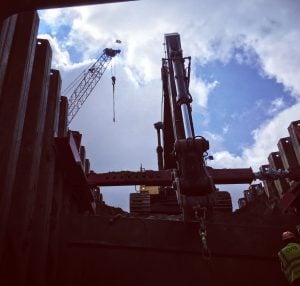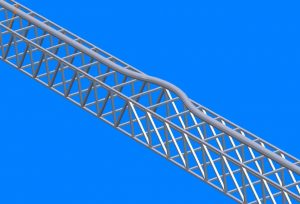My experience indicates that people easily get confused about suspended scaffolds. I’m not sure why that is other than it may have something to do with their knowledge, or lack thereof, of suspended scaffolds and how they work. This shouldn’t be surprising since most people base their knowledge on what they have seen on the evening news. Here are a few questions that occur about suspended scaffolds:
What is a suspended scaffold? This is a fundamental question that has an easy answer. A suspended scaffold is any temporary elevated platform that is supported by a non-rigid means, such as by rope or chain. For example, if you have a platform hanging by your mother’s clothesline, it is a suspended scaffold.
Do all suspended scaffold platforms have to be supported by wire ropes? No. You can use anything you want as long as the support is strong enough. This can be clothesline (see answer above), wire rope, cable, manila rope, chain, string, duct tape, bungee cords or rubber bands. As long as it has the required strength, and you can prove it, you can use it.
What is the required strength of wire ropes? It depends on what you are trying to hold up. For temporary suspended scaffolds used in construction and general industry, the safety factor must be at least 6; that is, the suspension line must be 6 times stronger than the load you are placing on it.
Can I really use duct tape? Well, if you can prove that it will hold 6 times the load you put on it, then you can use it. I have no idea how you would prove that so I strongly recommend against using it, even if it is “professional grade” duct tape!
Is there a difference between temporary suspended scaffolds and the scaffolds that commonly called “permanent installations”? Yes there are considerable differences. Different regulations and standards apply. For example, temporary suspended scaffolds used in construction in the United States must comply with the applicable OSHA construction standards [29 CFR 1926]. A Permanent Installation, (also known as a “P.I.”), must comply with OSHA standards that specifically address P.I.’s. The significant differences are in the areas of safety factors and fall protection requirements.
I have a 5/16” wire rope but do not know anything about it. Are all wire ropes of the same diameter the same? Absolutely not; wire rope strength varies based on the tensile strength of the steel used. Therefore you must have the data on the wire rope to determine its strength.
Why are wire ropes twisted? They aren’t twisted but rather are “laid” into strands. The strands make up the wire rope. There are a variety of “lays,” such as the Regular Lay and the Lang Lay. Different lays have different handling characteristics which means that you should select the wire rope with correct lay for the job.
The safety factor for temporary suspended scaffolds used in construction is 4. Does this also apply to the suspension rope? No. The minimum safety factor for the suspension rope is 6.
Why are suspended scaffolds so dangerous? They aren’t. If you utilize properly designed and maintained equipment, erect the scaffold correctly, and use it correctly, it’s no less safe than any other construction or maintenance activity.
I saw a worker on a suspended scaffold not connected to a vertical lifeline. Is this legal? Who cares if it is legal—is the worker safe? Typically, a worker on a single or two point temporary suspended scaffold is required to utilize both a guardrail system and personal fall protection equipment. However, on some temporary 2 point scaffolds the personal fall protection system may be built into the scaffold and rigging. Depending on the design of Permanent Installations, vertical lifelines may not be required due to its design. Obviously, before you use a suspended scaffold you must know what the fall protection requirements are.
Can I ride on a suspended scaffold without knowing how to operate it? Yes you can.
What do I need to do to be safe on suspended scaffolds, whether or not they are permanent or temporary installations? You need training in the specific type of equipment you are using.
Where can I get training on how to use and operate suspended scaffolds? Well, that should be evident if you are reading this magazine! The Scaffold Industry Association.













